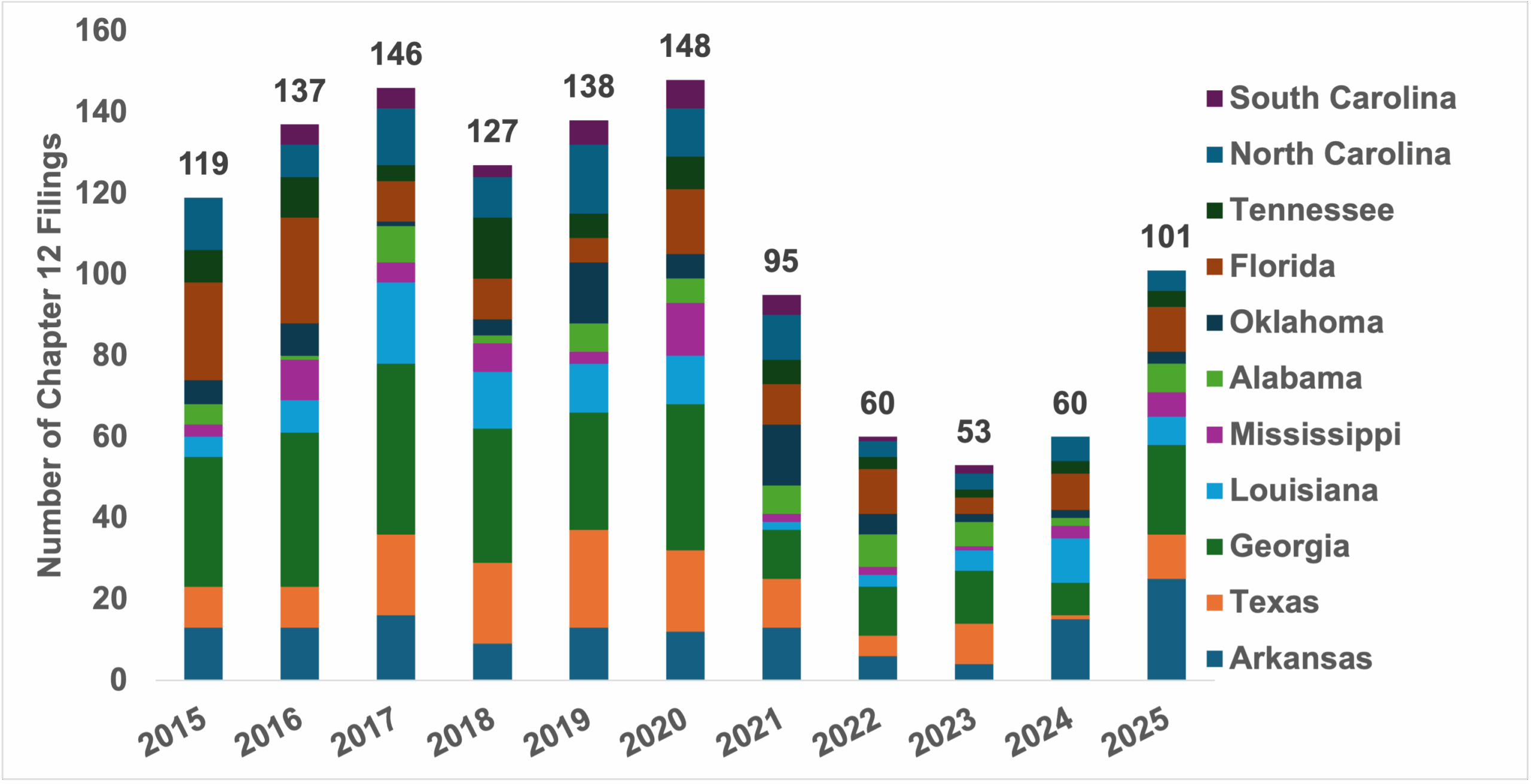What is Chapter 12 Bankruptcy?
Chapter 12 bankruptcy is a provision under the U.S. Bankruptcy Code tailored specifically for family farmers and fishermen. Introduced in 1986 during the height of the farm crisis, Chapter 12 allows qualifying family farmers to restructure their debts while continuing to operate. It offers a more flexible repayment structure than Chapter 11 or Chapter 13.
Chapter 12 Filings in the Southern Region
Data from 2015 to 2025 (measured from July 1 of the preceding year to June 30 of the labeled year) highlight important developments in Chapter 12 bankruptcy trends across the southern United States. Total Chapter 12 filings in the south have fluctuated over the past decade, peaking at 148 filings in 2020 before sharply declining to 53 in 2023 (see Figure 1). This decline aligns with post-pandemic trends across the United States due in part to government assistance and higher commodity prices, which improved short-term farm financial conditions. However, the most recent year of data (e.g., July 1, 2024 – June 30, 2025) shows a rebound to 101 filings. This may suggest that on-farm financial pressures are intensifying for southern producers.
Figure 1. Total Chapter 12 Filings for the Southern Region, 2015 – 2025

Source: UScourts.gov
Digging deeper into state-level filings reveals that Georgia, Texas, and Arkansas account for a large share of filings over the 2015 to 2025 period. Georgia recorded the highest total filings, with more than 30 annually through 2018 and peaking at 42 in 2017. Arkansas has shown a significant surge in the most recent reporting period from 4 filings in 2023 to 25 in 2025 (Figure 1). This increase in Chapter 12 filings signals financial stress in Arkansas despite more stable trends in neighboring states (e.g., Mississippi). The current state-level differences may point to uneven financial pressures within the southern region, which is likely shaped by crop mix, farm size, or local crop production systems. The 2025 rebound in filings could be due to the cyclical nature of agriculture following several years of low bankruptcy filings. But the increase also raises concerns about on-farm financial stress in southern agriculture. For smaller family-owned operations with limited liquidity, these pressures can become untenable, making bankruptcy not just an option, but a necessity.
Farm operations are often generational legacies, woven into family identity and rooted in the community. For many, bankruptcy is not only a financial loss but also an emotional burden. Bankruptcies serve as a reminder that financial stress in agriculture extends beyond the farm. It often impacts families, rural communities, and personal well-being. Tight (or non-existent) margins, increasing input costs, and mounting debt pressures can erode both financial stability and a producer’s sense of identity. These realities highlight the importance of timely support through open conversations, proactive engagement, and access to financial and mental health resources, including dedicated services such as the National AgriStress Helpline (1-833-897-2474) and the SAMHSA Disaster Distress Helpline (1-800-985-5990), both of which are available 24 hours a day, seven days a week. As pressure continues to mount, directly addressing farm stress is essential to sustaining farm operations and safeguarding the vitality of families and rural communities.
References
Loy, Ryan, and Hunter Biram. “The Disparity Between Crop Prices Received and Input Prices Paid.” Southern Ag Today 4(28.3). July 10, 2024. Permalink
Fields, Erica, and Ronald Rainey. “Identifying Financial Stress in Farmers and Ranchers: A Guide for Families, Friends, and Agricultural Community Stakeholders.” University of Arkansas Factsheet. Retrieved from: https://www.uaex.uada.edu/publications/pdf/FSA96.pdf
USDA-Economic Research Service (2025). Farm Sector Income & Finances: Highlights from the Farm Income Forecast. Retrieved from: https://www.ers.usda.gov/topics/farm-economy/farm-sector-income-finances/highlights-from-the-farm-income-forecast/
USDA- Economic, Statistics, and Market Information System. (2025). Agricultural Prices. Retrieved from: https://usda.library.cornell.edu/concern/publications/c821gj76b?locale=en
United States Courts. (2025). Caseload Statistics Data Tables. Retrieved from: https://www.uscourts.gov/statistics-reports/caseload-statistics-data-tables
Loy, Ryan, Erica Barnes Fields, and Ronald Rainey. “Tracking Chapter 12 Bankruptcies in the South: 2015 – 2025 Trends and Identifying On-Farm Stress.” Southern Ag Today 5(37.1). September 8, 2025. Permalink

